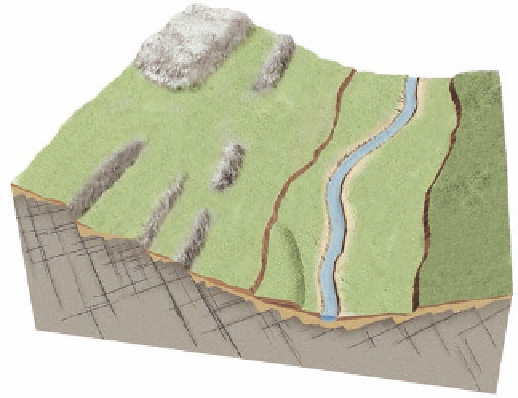Geoscience Reference
In-Depth Information
4.
The three major kinds of chemical weathering are
hydrolysis, oxidation, and carbonation. Hydrolysis oc-
curs when water interacts with rocks, causing chemical
reactions to occur. Oxidation occurs when oxygen com-
bines with metals to form oxides. Carbonation takes
place when carbonic acid in precipitation accumulates
on rocks and causes them slowly to dissolve.
is dumped, its slope naturally moves to the angle of repose
(Figure 14.14).
Generally speaking, most landscapes contain a variety
of hillslopes that grade downward to a stream of some size
(Figure 14.15). The
local relief
of the area—that is, the ver-
tical distance between the top of the hills and the stream
downslope—may have been created either through uplift of
the landscape or through downcutting by the stream. In some
cases, both processes occur.
Regardless of how the relief was created, the resulting
hillslopes contain many distinctive components. In all prob-
ability, the core of the slope is some form of bedrock that
dates to either an igneous or sedimentary process that oc-
curred tens of millions or hundreds of millions of years ago.
In relatively humid areas, the solid core is mantled by rego-
lith, which, if you recall, is formed when rock is weathered.
Also recall that regolith is further modified through various
pedogenic processes at the surface to form soil. Depending on
the steepness of the hillslope and the regional environmental
conditions, the soil will be either well developed and thick,
or poorly developed and thin. Most mass-wasting processes
occur within the mantling regolith and soil, although where
relief is particularly steep, they may also impact outcropping
bedrock. Sediment that moves down the hillslope due to some
mass-wasting process is called
colluvium
. Collovium tends
to be deposited at the base of hillslopes because the gradient
becomes less at those locations and the energy to transport
sediment is lost.
Several different kinds of mass wasting occur on Earth,
as shown in Figure 14.16. Although these variations tend to
grade into one another, an association exists between specific
5.
Humans have increased the amount of chemical
weathering downwind of industrial cities through the
process of acid rain. Most of these acids come in the
form of sulfur dioxide and nitrogen oxides derived from
coal-burning power plants.
Mass Wasting
Once sediment is liberated from rock in some fashion as a re-
sult of the weathering process, it can be moved and deposited
by gravity, wind, waves, or flowing water and glaciers. In this
way, the Earth's landscape is modified and shaped to form
features such as hills, valleys, beaches, and sand dunes. The
remainder of this chapter will focus on the effect of gravity
and the role it plays in landscape evolution by moving large
volumes of sediment through the process of
mass wasting
.
From a geographical perspective, the place to consider
mass wasting is on hillslopes, which are land surfaces inclined
at various angles from the horizontal. This process takes place
when the downward force of gravity overcomes the resist-
ing force of the slope material's shearing strength—in other
words, its cohesiveness and internal friction. The point at
which sediment becomes unstable is called the
threshold point
and depends a great deal on the material's
angle of repose
.
This angle is the natural maximum slope that any deposit of a
particular kind of sediment—for example, sand—can achieve
without moving under the force of gravity. The angle of re-
pose ranges between about 25° for fine sands and approxi-
mately 40° for angular pebbles and cobbles. You can see these
relationships when you see piles of sediment deposited at con-
struction sites or sand and gravel quarries. After the sediment
Typical hillslope
Rock outcrops
Regolith
Soil
layer
Joints
40°
35°
25°
Bedrock
Stream
Colluvium
Fine sand
Coarse sand
Irregular pebbles
Figure 14.14 The angle of repose.
The angle of repose is the nat-
ural maximum angle at which sediments of a given size can rest be-
fore they begin to slide under the force of gravity. In general, coarse
sediments have a steeper angle of repose than finer sediments.
Figure 14.15 Generalized view of a typical hillslope.
Hillslopes
typically have distinctive characteristics that are easily visible.
Note the relationships of bedrock, regolith, soils, and valley
stream in the image, which are common in many hillslopes.
Mass wasting
Movement of rock, sediment, and soil downslope
due to the force of gravity.
Colluvium
Unconsolidated sediment that accumulates at the
base of a slope.











